As we are around a year from the initial launch of 12th Gen Intel Core “Alder Lake” Project TinyMiniMicro nodes, they are in a unique position being both found new through HP and used through secondary markets. That allowed us to purchase a HP Elite Mini 800 G9 1L business desktop PC to see how it fares compared to other units we have reviewed. What we found made a lot of sense, until we started on a second piece with this unit, adding a 10Gbase-T NIC where we found a change that HP made that could lead to a lot of eWaste in the future. Let us get to it.
HP Elite Mini 800 G9 Overview
As is our custom with Project TinyMiniMicro, we have a video for this.
As always, we suggest watching this in its own browser, tab, or app for a better viewing experience. You can also see/ hear the power consumption tests live.
If the HP Elite Mini 600 G9 was a “mistake” purchase, this is the unit we meant to purchase. The Elite Mini 800 G9 was $515 on eBay. When it arrived, it was in fabulous shape, barely used. The NVMe SSD it came with had one power-on hour via SMART monitoring tools.
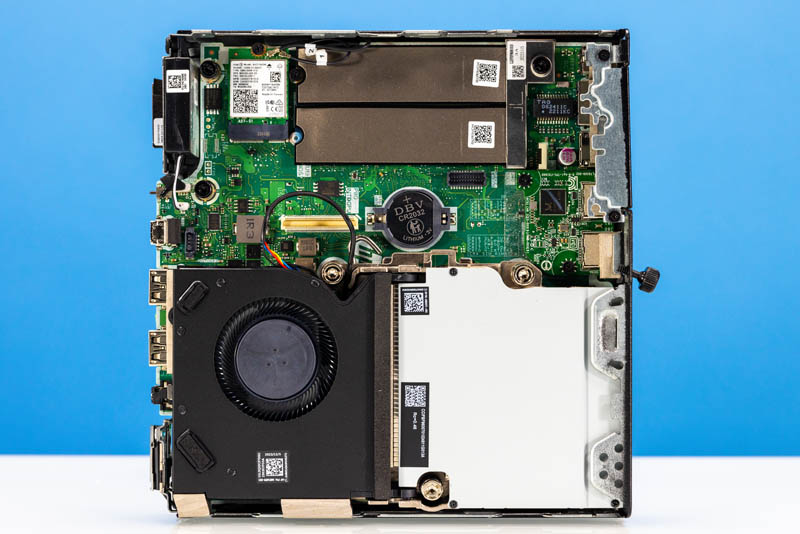
Our system came configured with a single 16GB DDR5-4800 SODIMM and a 256GB NVMe SSD. The SSD is a Western Digital SN810. Other vendors, like Lenovo, have their own brand of SSDs, but HP is using a WD brand drive.
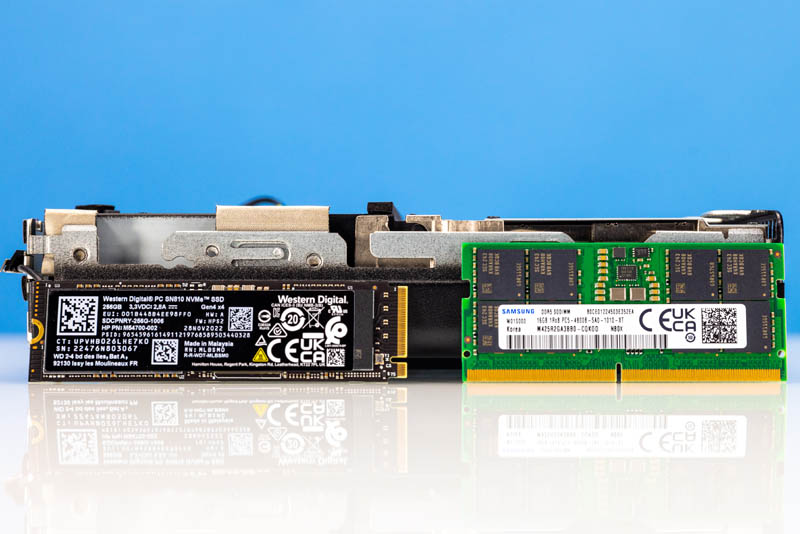
The CPU we received was an Intel Core i5-12500T. That is a 6-core / 12-thread CPU with only performance P-cores. While this is a good CPU for OSes like VMware ESXi, where heterogeneous cores require a workaround, given that we paid less for the i7-12700T in the Elite Mini 600 G9 it made us less excited about this one. That is a function of used pricing. Also, it just feels like 6C/12T is something we should be moving beyond in the i5-x500T series. Our favorite SKUs in Project TinyMiniMicro had been the Core i5-6500T, i5-8500T, and i5-10500T. Alder Lake is a big upgrade, but we get a clock speed and architecture jump, not a thread increase like those other even series SKUs.
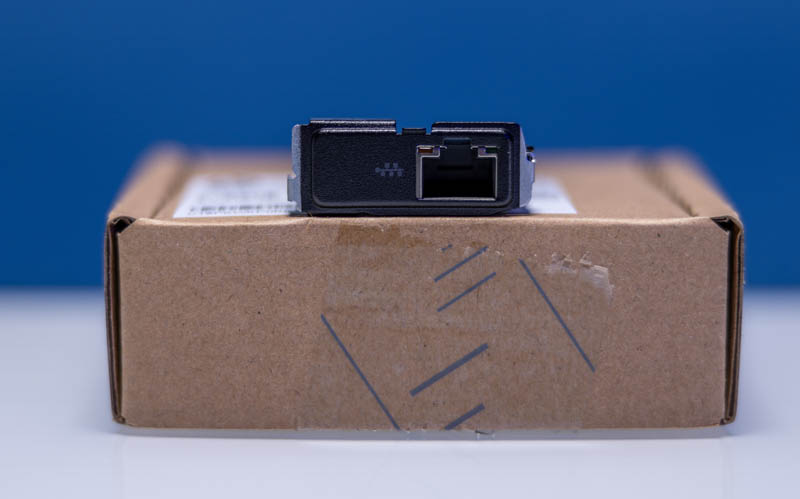
This unit is also the first we tried with not just the 2.5GbE Flex IO NIC, but also the 10Gbase-T Flex IO V2 NIC. The 10GbE version led us to a rough day.
We are going to point to our HP Elite Mini 800 G9 with Intel Alder Lake launch piece for a bit more around renaming the EliteDesk to Elite Mini line with this generation. Instead, let us get to the hardware.
HP Elite Mini 800 G9 External Hardware Overview
The front of the unit has three USB ports. One Type-C and two Type-A. The two USB 3.2 Gen2 Type-A ports are 10Gbps ports while the Type-C is a 20Gbps port. USB4/ Thunderbolt is not standard, but it is an option in a flexible rear slot. This is the same front connectivity as we saw on the Elite Mini 600 G9.
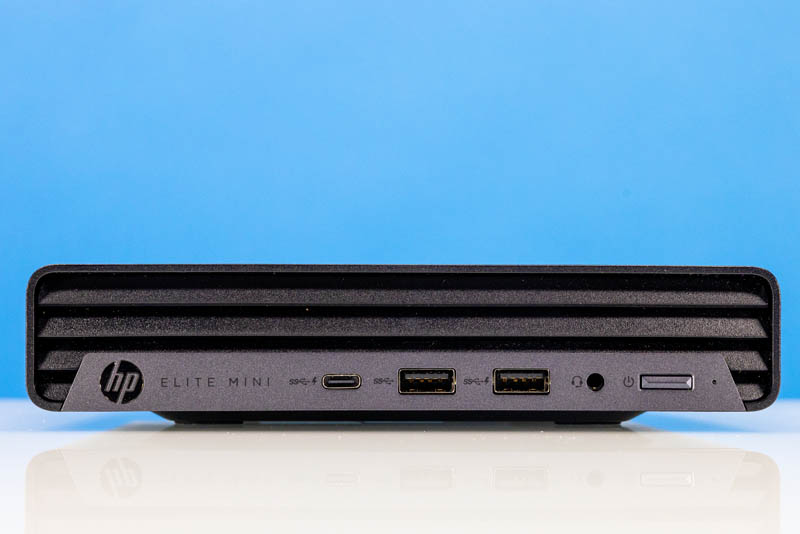
The front also has the headset combo jack and the power button.
The rear of the unit is where most of the action happens. There are two DisplayPort 1.4a ports as well as a HDMI 2.1 port. We also have three standard USB 3.2 Gen2 10Gbps ports and an Intel i219-LM 1GbE port.
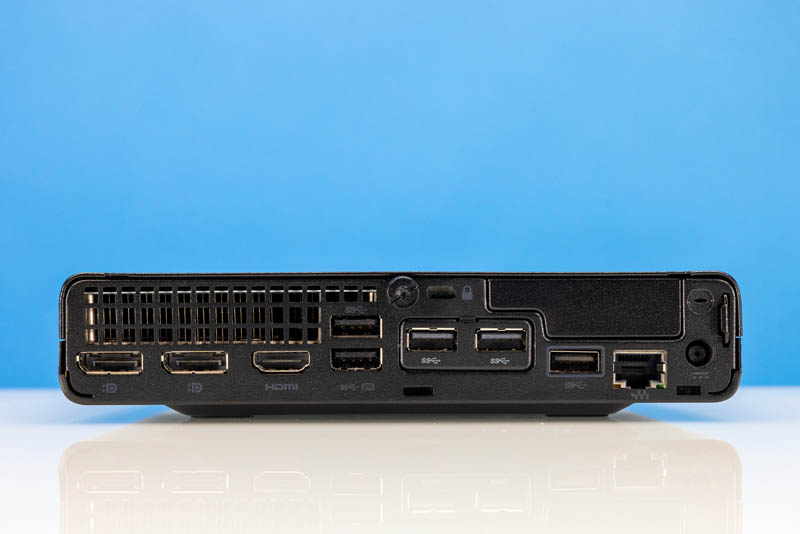
HP has two optional slots. The Flex IO V2 slot in our unit has the dual USB 3 (5Gbps) option. There are a ton of different possibilities here like TB/USB4, 2.5GbE, 10Gbase-T, USB-C and more. The other slot has options like USB 2 ports, serial, and WiFi antennas. It is used to provide the GPU I/O with the NVIDIA GeForce RTX 3050 Ti option.
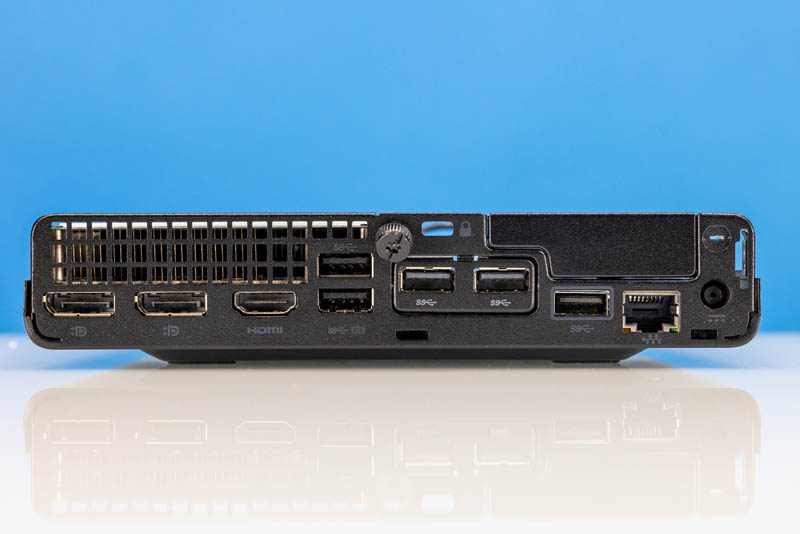
Coincidentally, this was the same dual USB Flex IO expansion module as we received on the Elite Mini 600 G9. While it is nice to have more USB ports, the other options are significantly more interesting.
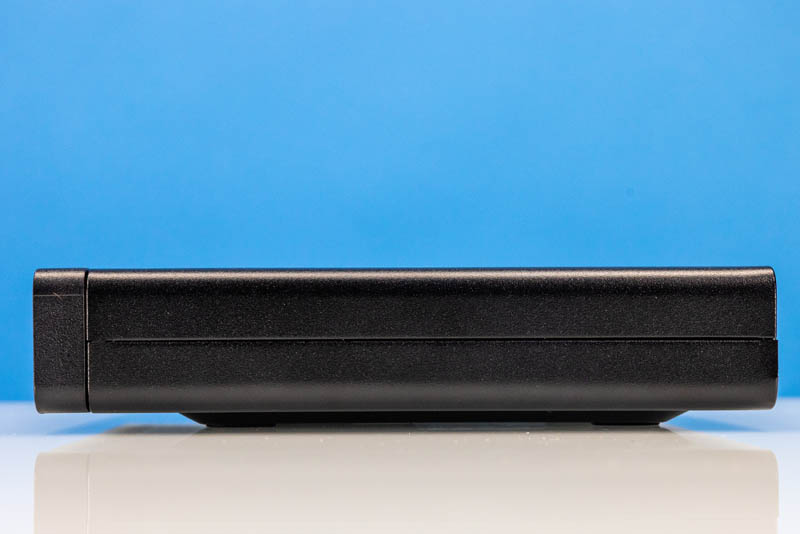
As a 35W TDP model, this unit does not have venting on either side. The Elite Mini 800 G9 has 65W TDP and GPU variants that require different cooling, but we tend to gravitate towards the 35W models for performance per watt benefits.
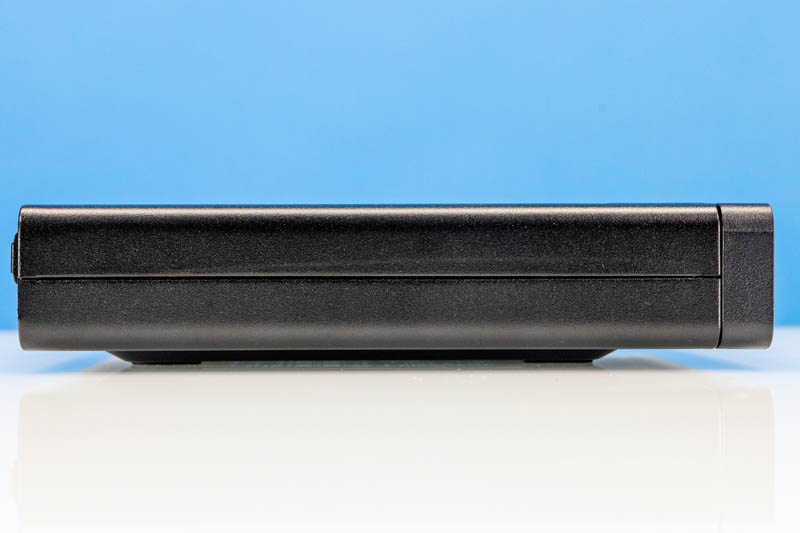
The top has our Intel Core i5 vPro sticker. The vPro support depends on the system and the CPU. The easiest way to tell if a system supports vPro is this sticker.
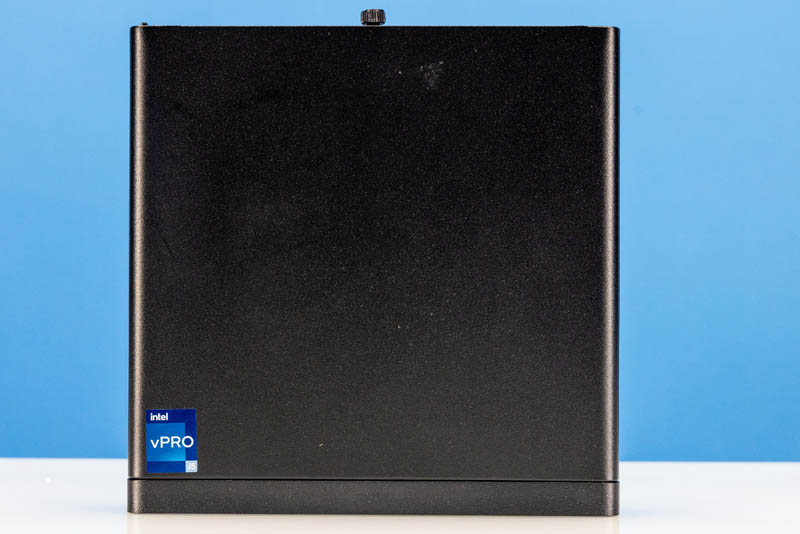
On the bottom, we get many regulatory markings and the Windows sticker.
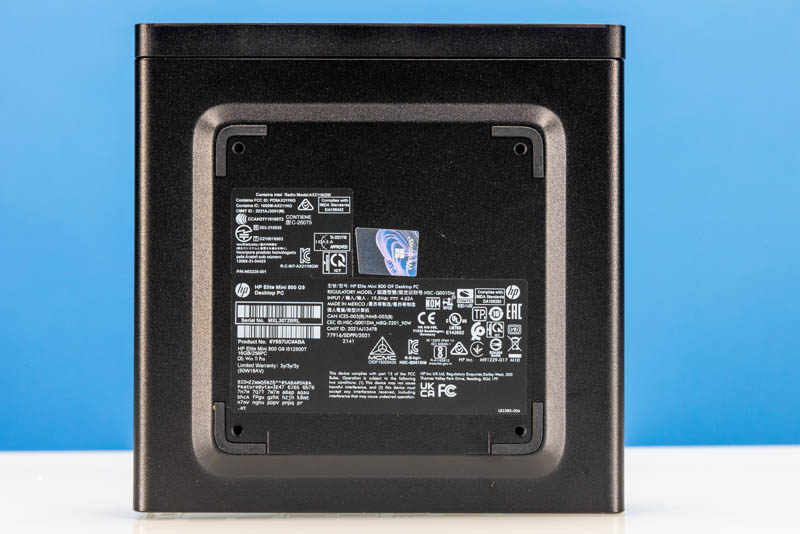
Next, let us get to our internal overview and performance.

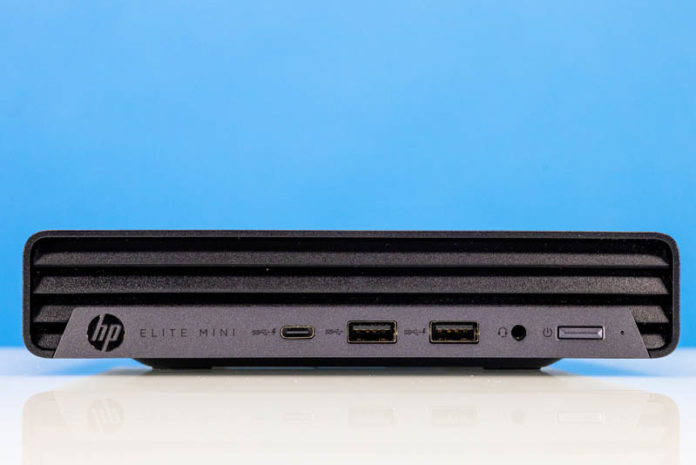



It’s amazing to me that the manufacturer of a product would resort to stealing images of their own product! That’s an unfortunate blemish on this otherwise thorough review.
I purchased a EliteDesk 800 G2 DM 35W with i7-6700T off of Amazon for 180 second hand in part thanks to your reviews (even though on newer ones) for a cheap low power ESXi box for a few things (Docker and a Blue IRIS vm) vs my Dell 730 which I generally turn off when not needed and I have been very happy with it so far. Given its power usage its a no brainer for some simple stuff.
HPE come on, how is this even possible? Stealing images of your own product from other sites!
Given the issues HPE has enforced with second hand hardware, I will always steer clear of HP and HPE. It’s unfortunate, but they have shown no desire to support the second hand market.
Anyone notice that Patrick’s You Tube thumbnails are beginning to look like a magazine rack at Barnes & Noble? Loud, yellow and red.
Bios password now follows laptop standard for security reasons. Makes perfect sense for mini PC chassis
I’m a bit confused. If the BIOS password was not included from the eBay vendor, couldn’t one just ask the reseller what it is? If the reseller doesn’t know, what does that mean about the origin of the device?
HP often use “hpinvent” as their default firmware passwords. You could try that Patrick if you haven’t already.
The story with the 10Gbe Flex module needs some expanding… did it work in the G6 systems? Any performance issues? Part numbers and prices?
Sucks that it bricked this system – but don’t leave us hanging!
I’ve seen similar irksome behavior from HP desktop systems(my favorite was the batch that accepted an HP-provided firmware update without complaint; then required a hands-on-keyboard entry of the BIOS password on every single unit before they were willing to boot again, that was fun to sort out), so I’m not surprised surprised; but from an architectural perspective I’m having a hard time understanding why swapping in any peripheral, much less a first-party option explicitly supported for a given model, would cause secure boot problems.
It would make sense if perturbing the hardware state caused the TPM to refuse to unseal any secrets it had previously stashed away; exactly how twitchy those are seems to vary by platform; but a change to internal PCIe peripherals would certainly qualify; but that also wouldn’t matter for a new-to-you system.
It would be sloppy; but not shocking, if there’s some sort of confusion with what keys are being used to sign the UEFI drivers for the 10GbE NIC vs. which ones are trusted by the 800 G9 firmware, and even less surprising if, hypothetically, it were a 3rd party card, so I wouldn’t necessarily bet on being able to use that NIC for PXE or other preboot networking; but that still wouldn’t preclude booting the system and letting the OS decide what it wants to do with the peripheral.
It sounds like HP is either classifying an unrelated anti-tamper/configuration lockdown feature as part of ‘secure boot’ or taking an atypically expansive interpretation of what that means.
The card was purchased still HP sealed via distribution (Ingram IIRC?)
Pierre – yes. More on that soon. https://forums.servethehome.com/index.php?threads/review-request-hp-flex-io-10gbit-module.39590/
The 10Gbe module looks interesting. I’ve got 2x i5-12500 and 2x i7-12700’s in my setup. Oddly enough the i5s do not have a vPro sticker but have all the full vPro functionality including full AMT. not sure if they just ended up with wrong stickers. All units purchased at massive discounts and much like others have seen, had hardly any use. One had only 8 hours power on. Great for homelab setup
I just took off the heatsink to swap the CPU to a i9-13900T and saw there was a button labeled with BIOS, maybe this is the magic button
Be aware, if you desire to run two M2 drives, you’ll require additional cooling. The second you fill both M2 slots, the system will post with a 901 error that you cannot bypass.
You will require the 2.5″ SATA tray (HP Part No. 13L70AA) that includes an additional cooling fan. Once connected, the system will move throgh post without issue.
Of course, this part is a bit challenging to come by much like the 10G NIC modules there for awhile.
Not sure why HP would even allow these to be sold without the extra cooling by default when they tout being able to run both M2 slots.
These are great little machines… I have 3 in a cluster that gives me one hell of a homelab or more compute in a small space than many SMBs or Mid-size orgs I’ve supported.
Hey Patrick,
I was watching your youtube video recently and you said the motherboard doesn’t have a CMOS reset jumper. Well, recently I borrowed one of those systems from a good friend of mine, its the Elite Mini 800 G9 with i9-12900T. While upgrading the RAM I noticed there’s a tiny little button sandwich between the SODIMM slots and the CPU heatsink, labeled CMOS. Isn’t this used for resetting the UEFI/BIOS? I also noticed removing the battery for 30 seconds can reset the UEFI/BIOS (but this may depend on the board’s initial settings). Thanks keep up the great videos!
And for SentientNumber6.
I have two Samsung 980 Pro M.2 installed on my G9 Mini and it doesn’t have any issues, even without the SATA cage it boots up fine. Not seen any errors at all! Maybe you should try reseating those drives?
Hey, I was actually about to buy a used G9, but asked if the BIOS pw was set, it is!
Thanks for making me aware of this.
Has anyone figured out, if it can be reset in any way?
I am still in talks with the seller, the price is good and it would be perfect.
A bummer you did not get the unit Nils, but better to save the headache and figure it out beforehand.
I’ve just installed a Google Coral TPU in my EM800 G9 (i5-12500) and it’s working great. VEry low power usage and now allows me to do processing using the TPU for Frigate in a Proxmox LXC. So far rock solid
I got one with i7 12700, and every time it’s under load it starts producing a screeching sound. It seems to be coming from somewhere around the CPU. Otherwise it’s almost completely silent, even when the fan is spinning. Anyone else getting that noise? Could it be that low quality that it’s normal, or is mine about to die?
Turns out the power supply of 90W wasn’t enough for it. After getting a 150W power supply there’s no more screeching and CPU-Z benchmark went up from 3.5k to 7k points.
Great review. I bought the i5-12500 model.
I want to buy the wifi card – the unit didn’t include it.
Do you know which exact model I should pick ?
I can’t find any reference on HP website ..
I went as far as replacing the bios chip to get rid of the password on an HP mini G6.
I flashed the replacement with default image prior to the board rework.
Worked great until the next time I powered it on, and then the password was back.
Sounds like this is common now, and I’ve heard of the same behaviors on Lenovo systems.
I’ve also heard there is a 2nd BIOS failback chip and a hash is used somewhere to track if a restore is necessary – possibly if both were replaced at once with default images it MIGHT work (or the HP Wolf security features may check with a server somewhere and re-download settings?).
Overall, it is MUCH more secure than it used to be. Annoyingly so, but IT departments are probably happy doer security reasons.
I would really appreciate it if you could test these machines in a lower noise environment. This provide has a TUV Rheinland ultra low noise certification which means it should have an operating noise level of 22 – 25dB(A). It isn’t possible to verify this if your studio noise floor is higher than this.